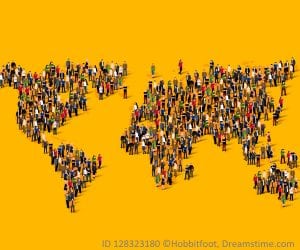Religion Demographics of the World
Since the beginning of humanity, people have sought reasons for the creation of our world and our intelligent species. This gave rise to structures of beliefs and practices that were later defined as religion. French sociologist Émile Durkheim (one of the principal architects of modern social science), argued that religion is the most fundamental social institution, and, in one form or another, will always be a part of social life. Population growth, through history, has been inextricably tied to the expansion of religious life. Today, some 85 percent of people around the globe identify with a religion.
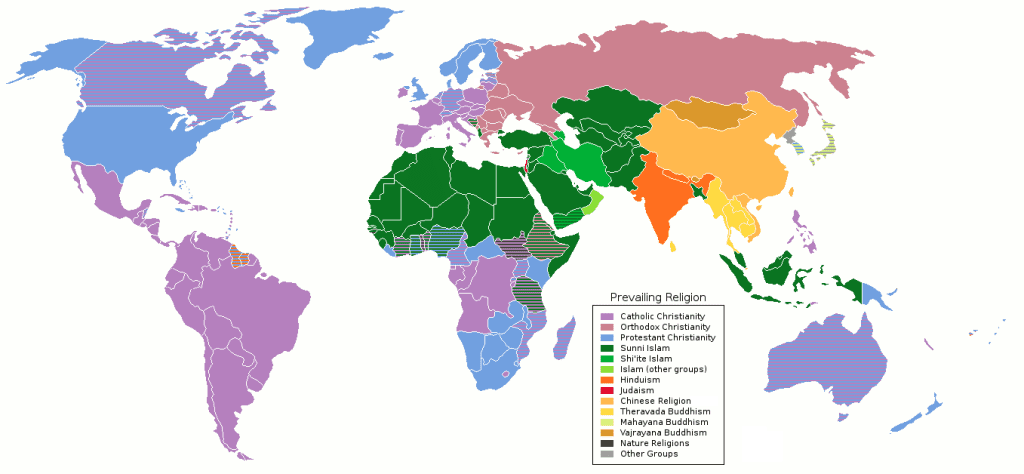
The Four Largest Religions in the World
While there are around 10,000 distinct religions in the world, over three-quarters of the global population adheres to one of these four – Christianity (31%), Islam (24%), Hinduism (15%), and Buddhism (7%).
Demographics Of Christianity
Christianity, a faith that began nearly 2,000 years ago in the Middle East, is now followed by 2.4 billion people, and is the primary religion practiced throughout the Americas, Europe, Oceania and sub-Saharan Africa. Half of Christians identify as Catholic, 37 percent Protestant, 12 percent Orthodox and 1 percent “Other”. The United States is home to the largest Christian population (11.3% of the world total), followed by Brazil (8%), and Mexico (5%).
Islam Demographics
Islam, founded in 622 CE, now has nearly 2 billion followers, the majority identifying in the two largest sects, Sunni and Shia. Muslims (followers of Islam) come from diverse ethnic backgrounds, speak hundreds of languages, and are the majority in 49 countries, covering the Middle East, Northern Africa, and parts of South Asia. The countries with the largest proportions of the world’s Muslim population are Indonesia (13.1%), India (11%), Pakistan (10.5%), and Bangladesh (8.4%). Karachi, Pakistan has the largest Muslim population of any city.
Hinduism Demographics
Hinduism is one of the oldest religions, beginning in Northern India around 2000 BCE. The overwhelming number of today’s 1.2 billion Hindus live in India and Nepal.
Buddhism Demographics
Buddhism, also with its roots in Ancient India, started in the 5th century CE. Countries with large Buddhist populations include Mongolia, Thailand, Myanmar, Laos, and Cambodia. About half of the world’s 500 million practicing Buddhists reside in China.
Religions with Smaller Followings
Another 7 percent of the global population identify with religions with much smaller followings. Judaism, though one of the three major Abrahamic religions (along with Christianity and Islam) is represented by just 0.2 percent of the global population (16 million), most of whom reside in Israel (7 million) and the U.S. (6 million). Had the Holocaust not wiped out over a third of world Jewry during World War II, it is likely the Jewish population would be twice the size it is today.
An estimated 6 percent of the world’s population are adherents of folk or traditional religions. These include African traditional religions, Chinese folk religions, Native American religions, and Australian aboriginal religions. Another 1 percent follow a variety of other faiths, including Baha’i, Taoism, Jainism, Shintoism, Sikhism, Tenrikyo, Zoroastrianism, Wicca, and many others.
The Non-Religious Population in the World
About 16 percent of people around the world have no religious affiliation. These “nones” include atheists, agnostics, and people who may believe in God or spiritual life but do not identify with any particular religion. The countries with the largest unaffiliated populations include China, Japan, and the United States. In the case of the United States, those who reply “none” when asked about religion, have grown from 8 percent of the population in 2000 to 21 percent in 2022. In China and Japan, along with South Korea, North Korea, Czechia and Estonia, the majority of the populations have no religious affiliation.
Fertility Rates and Religion
According to Pew Research, the most religious areas of the world are experiencing the fastest population growth because they have high fertility rates and relatively young populations. Niger, the country with the fastest growing population in the world (3.7% annually) and the highest fertility rate (6.8 children per woman), is expected to quadruple its population by 2070. At the same time, the vast majority of adults in Niger (86%) say religion is very important to their lives (as compared to 54% worldwide). On the other end of the spectrum is Japan, where only 10 percent of their shrinking population (-0.5% annually) consider themselves religious. Japan’s population is expected to drop by 28 percent over the next 50 years.
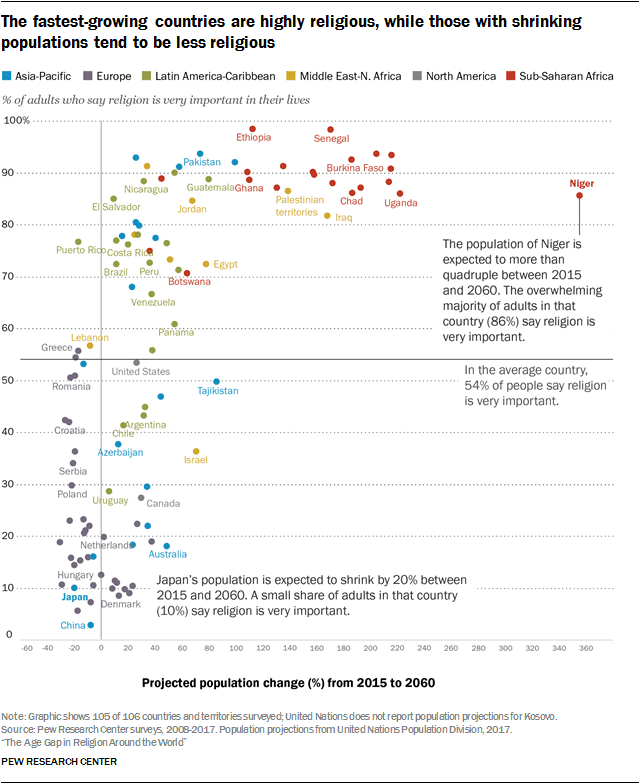
Fertility Rate In Islamic Countries
Among the major religious groups Pew studied, Muslims had the highest fertility rate in 2015-2020 (2.9). The median age among Muslims was 23 during that time period, with over a third (34%) in the youngest segment of the population (birth – age 14). This compares to a median age of 28 for the world population with 27 percent ages 0-14.
Fertility rates in Muslim-majority countries, as with all countries, track closely to educational attainment for women. In the eight Muslim countries where girls complete the fewest years of school, the average fertility rate (5.1) is more than double the average rate (2.4) in the nine Muslim-majority countries where girls receive the most years of schooling. In Islam, influence over a person’s reproductive choice depends on that particular culture’s views on family planning and, to a great extent, a woman’s status. Fertility rates are higher among Islamic countries, such as Algeria and Pakistan, where education and jobs are less accessible to women than in other Islamic nations with more opportunities for women, such as Tunisia and Turkey.
Christian Fertility Rate
The world’s Christian population also has continued to grow, with a fertility rate higher than the world average (2.6 in 2015-2020, as compared to 2.4 for the world average). In recent years, 33 percent of the world’s births were from Christian parents, which is slightly greater than the Christian share of the world’s population in 2015 (31%). The fertility rate among Christians was lowest in Europe (1.6) and highest in sub-Saharan Africa (4.4). Two predominantly Catholic countries, Italy and Spain, have some of the smallest average completed family size (1.3 children and 1.2 children per woman respectively) in the world. Although the Vatican maintains a ban on modern methods of birth control, the church supports programs that improve health and education for women and girls, efforts that lead to smaller families.
Fertility rates for Hindus (2.3) and Buddhists (1.6) have been lower than for Christians and Muslims worldwide. Completed family size for those unaffiliated with a religion has been considerably lower (1.6) than the world average.
It should be noted that fertility rates have been falling around the world and across all major religious groups, with predictions that they will all converge to replacement level (2.1) later this century. This is largely dependent on a cluster of factors including increased use of contraception, greater education and status for girls and women, greater access to improved health care, and economic growth. Historically, virtually all world religions instilled pro-fertility norms, reflecting the high infant mortality and low life expectancy that prevailed for most of human history. As child survival and longevity improved in the 20th century, beliefs and societal roles concerning gender and sexual behavior also began to change across different faith communities.
Religion and Government
For many, religion is more than personal – it’s embedded into their nation’s system of government. More than 20% of countries (43) have official state religions.
Countries With State Religions
Islam is the official religion in 27 countries in Asia and sub-Saharan Africa as well as North Africa and the Middle East. Of those 27 countries, eight consider themselves “Islamic states,” meaning they have adopted Islam as the ideological foundation of their state and constitution (Afghanistan, Brunei, Iran, Mauritania, Oman, Pakistan, Saudi Arabia, and Yemen).
A handful of countries consider themselves Christian republics, with Christianity the established religion. These include Argentina, Costa Rica, Finland, Greece, Armenia, Samoa, Iceland, and Malta. Two countries (Bhutan and Cambodia) have Buddhism as their state religion, and one (Israel) is officially a Jewish state. No country has Hinduism as its state religion.
Communism and Religion
In 10 countries, especially those with a history of Communism, the state is hostile to religion or tightly regulates religious institutions. These include China, Cuba, North Korea, Vietnam, and several former Soviet republics.
The Future Of Religion Throughout The World
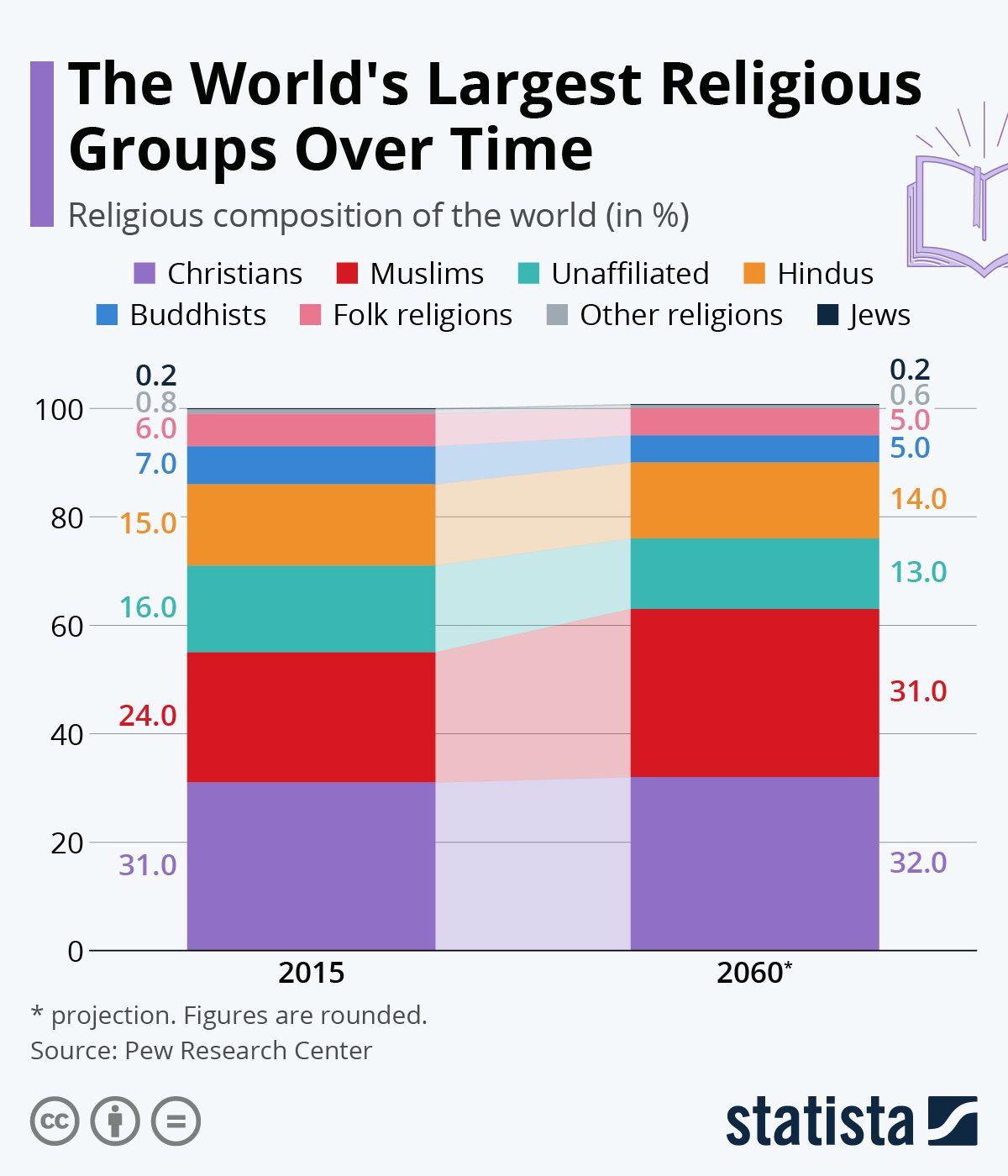 Although the ranks of the “nones” have been growing in the United States, this is not the trend worldwide. In fact, the proportion of those who don’t affiliate with a religion is expected to drop from 16 to 13 percent by 2060. This is largely because the most population growth is occurring in the countries with greater religiosity. A survey of 26 countries conducted by Ipsos Global Advisor found a high prevalence of religious affiliation and practice in the Global South with a larger secular population in the Global North. Population shifts and demographic changes may influence the distribution and prevalence of different religions globally. This could be due to factors such as birth rates, migration patterns, and religious conversion.
Although the ranks of the “nones” have been growing in the United States, this is not the trend worldwide. In fact, the proportion of those who don’t affiliate with a religion is expected to drop from 16 to 13 percent by 2060. This is largely because the most population growth is occurring in the countries with greater religiosity. A survey of 26 countries conducted by Ipsos Global Advisor found a high prevalence of religious affiliation and practice in the Global South with a larger secular population in the Global North. Population shifts and demographic changes may influence the distribution and prevalence of different religions globally. This could be due to factors such as birth rates, migration patterns, and religious conversion.
The numbers of Muslims and Christians are both expected to grow. By later in the 21st century, Muslims are expected to comprise the largest religious group in the world. Pakistan is expected to surpass Indonesia as the country with the single largest Muslim population. The growth of Islam will be most noticeable in sub-Saharan Africa, which is the fastest growing region of the world. As a result, more Muslims are likely to live in Nigeria than Egypt later this century.
The same is true of Christianity, which is expected to grow by 85 percent in Africa within the next 30 years. By 2050, 4 out of every 10 Christians in the world will live in sub-Saharan Africa. Christian denominations experiencing the fastest growth are Evangelicals and Pentecostals. By 2050, Pentecostals could account for roughly one-third of the 3.3 billion Christians. Pentecostalism is a movement that emerged in the early 20th century, emphasizing a personal experience with God, manifested through charismatic gifts such as speaking in tongues, healing, and prophesy.
Only modest growth is expected in the number of Hindus and Buddhists worldwide over the next 30 years.
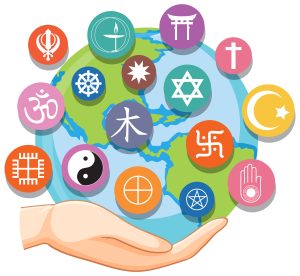
It is difficult to predict what the larger significance of these religious, demographic changes will be in the coming years. Religion can be a source of both conflict and cooperation. While some conflicts are driven by religious differences, there is also potential for religions to play a positive role in promoting peace, social justice, humanitarian, and conservation efforts. Religious practice can influence gender roles and desired family size, but is only one factor. People of all religious stripes are influenced by a variety of cultural, social and economic trends when making decisions about relationships and planning families.
Image credits: World map (LilTeK21 at English Wikipedia, CC BY-SA 3.0 via Wikimedia Commons); Religion and population growth chart (The fastest-growing countries are highly religious, while those with shrinking populations tend to be less religious by Pew Research Center); Largest religious groups over time chart (The world Largest Religious Groups Over Time by Statista); Clip art of global religions (Image by brgfx on Freepik)



